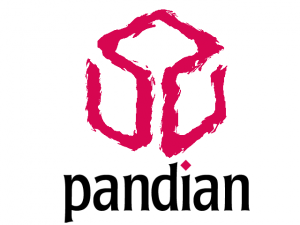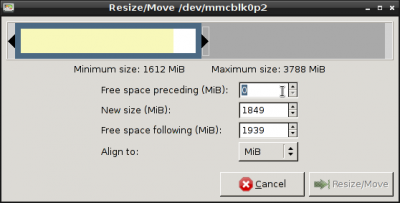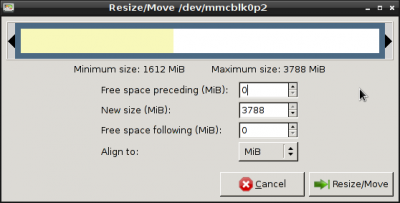Pandian
Pandian is an debian-based armhf desktop and CLI distro for your Pandora.
Contents
Help / Bugs / Features
Ideas, Bugs, or features-requests? Report to: http://www.evilbrain.de/projects/pandian/issues
MARK2
Second version
Full Debian GNU/Linux based on sid branch with LXDE desktop environment (normal) or CLI (minimal-) build.
hardfloat armv7l yule release Date: 29.12.2013
forum link
Main Features
- The debian way.
- Access to all packages from debian software repositories.
- Debian repository hosted on http://pandian.openpandora.org so keep pandian scripts up to date
- armhf means float operations are relegated to special hardware for this rather than taxing the main cpu (as with softfloat)
Requirements
- Of course a Pandora ;) All versions fine?
- SD card minimum 2GB ( was tested with 4GB )
- A Linux or Windows PC for putting the install on the aforementioned SD-card.
Which version is right for you ?
There are two different versions of the "MARK2" release:
| Version | Description | Link | Checksums |
|---|---|---|---|
| normal | pandian with fully Desktop environment ( LXDE ) | filedropper: pandian-mark2-hf2014-01-02 pandian.openpandora.org: pandian-mark2-hf_2014-01-02.7z |
pandian-mark2-hf_2014-01-02.7z 3731d70a4d8ec59e79a046f34f69c5c809be73e38cfc91a5b580478b8f8c222f pandian-mark2-hf_2014-01-02.img 83b8d3fa5bd0588cfb8b11cfe6b827819e6311e98396a6e32c46c9692f072e96 |
| minimal | pandian without any Desktop environment but with the basic pandian package | filedropper: pandian-mark2-minimal-hf2014-01-02 pandian.openpandora.org: pandian-mark2-minimal-hf_2014-01-02.7z |
pandian-mark2-minimal-hf_2014-01-02.7z a35106473e54c55d64c7eae2088d8c267b605baf17d5338b8e2938dbfe3c01ca pandian-mark2-minimal-hf_2014-01-02.img c68a42c1aef0238c1dd6ff33b628a2c0dea812a7b5b2d906afb185f93f940f84 |
- "normal" is intended for regular users, who want a easy desktop that just works.
- If you don't like LXDE as Desktop you can change it, adding a user interface atop the minimal install is more advanced as setup of USB-Networking or interfaces for wifi is needed to do so.
- Every setting of MARK2 is split into debian packages which are hosted on http://pandian.openpandora.org
pandian package ( the basis of "minimal" )
Core package which contains following features:
- ACPI support for brighter/darker-buttons, for lid and for low-power-mode
- first-use-wizard
- automount ( for USB-Stick, external Hard-Drives etc )
- alsa sound support
- pdcmd
pandian-lxde package ( what is added to make it "normal" )
Meta package featuring
- full desktop environment (LXDE)
- Easy Wifi-Access trough network-manager
- MediaPlayer ( mpd with gurlp )
- nub-support
- calibrator-application
- After you download the files, verify the checksums to make sure the integrity of the file downloaded matches in being an exact copy of the file downloaded from the server
- open a terminal
- md5sum ~/downloads/pandian - - -- .7Z (input where you have the file and the one you chose to download)
- make sure it matches the given md5sum, if not, try to download another copy.
Putting the downloaded image on SD-card
Linux
Verify your SD-Hardware
Check where your SD-Card is located. If you have an build in SD-Card-Reader this is normally /dev/mmcblk0p1 ( in Debian ) If you have an USB-Card-Reader this is something like /dev/sdc ( in Debian )
- Open an Terminal and input "lsblk"
- You get an list with the actual Block-Devices
- The SD-Card should be as type disk
You can also try gparted to see which devices you have and identify the SD-card
Unzip
- Unzip with 7z ( in Linux with 7zr e <image.7z> )
Copy the image to the SD-Card
| Warning, this will destroy everything on the device ! So please be very sure which device is you SD-Card ! |
- Here it will be /dev/sdx
(note that its sd and then a letter, sdc for example not the following number, as that is the partition, we are using the base card here) This means considerations for partitions and filesystem are taken care of, so no need to worry about that. Do not pick the wrong drive however, since dd will happily write the image to somewhere it isnt supposed to if you tell it to)
- Copy image to SD-Card with "dd if=<image.img> of=/dev/sdx"
You now have Pandian installed on your SD card and its ready to go. :) However after copying the image to the SD-Card resizing the partitionspartitions is needed to fully utilize the space, since by default the install is limited to 2GB. (If your card is bigger Pandian is still limited to those 2GB)
Resize SD-Card
- This can be done with gparted on linux|gnu
- start gparted
- After everything is fine, you have your new fresh Pandian on you SD-Card
First-start
- Upon first boot of Pandian, there is a first-start-wizard which guides you through some basic settings.
- Inside a dialog you can navigate with the cross
- With space you select a checkbox
- Moving between <Ok> and <Cancel> can be down with the use of TAB ( Tap Fn then tap Space )
- Acknowledge with Enter
Update ( Optional )
- After you setup your Pandora, it is useful to update your system. It is a rolling release, which means since the image was made, the system is forever updated with new packages.
- open a terminal
- get root ( command is: "su" )
- enter "apt-get update" to download package information from the repositories
- enter "apt-get upgrade" to update all packages that are out of date
(pandian packages are also updated this way :)
Preinstalled packages
These are the packages which come with the different versions of MARK2:
minimal
LXDE
- of course LXDE
- Text-Editor: medit
- Audio: mpd als backend, glurp as frontend
Additional Users/Groups
There are additional Users/Groups added to the standard debian-users
Groups
- admin
- This superuser privilege is used by sudo for admin task like shutdown etc.
- mpd
- This user/group has access to mpd-related files ( socket, pid-files )
User-Guide Section
Power-Modes
LID-Close
- If the lid is closed only the screen will be disabled
Low-Power-Mode / Shutdown
- Switch to left: Pandora will go to low power mode ( reduce CPU, Disable LID, Pause processes )
- Switch to right: Shutdown the pandora
pdcmd
- This script handles all system-related stuff, like lid, low-power, usb or wifi.
- This should run as root
Usage:
| Command | What's done |
|---|---|
| /usr/sbin/pdcmd LCDBright + | Increase the light of the lid |
| /usr/sbin/pdcmd LCDBright - | Decrease the light of the lid |
| /usr/sbin/pdcmd LCDBright 10 | Set the Brightness of the lid to 10 |
| /usr/sbin/pdcmd LCDTrigger | Trigger the lid ( WARNING: THIS DISABLES THE LID ! ) |
| /usr/sbin/pdcmd USBNetTrigger | Enable the USB-Networking (module g_ether). If usbnetworking is on, it will disable it |
| /usr/sbin/pdcmd USBHostTrigger | Enable the USB-Host (module ehci-hcd). If USB-Host is on, it will disable it |
| /usr/sbin/pdcmd WLANTrigger | Enable Wifi. If Wifi is enabled it will be disabled |
Old releases
01
Full debian GNU/Linux 7.2 codename Wheezy (stable) with LXDE desktop environment
hardfloat armv7l released Date: 29.09.2013
forum link
Features
- Hard-Float-ABI
- Ext4 Root for better performance
- Working Touch-Screen
- Working Nubs
- Screen-Off on LID-Close
- Low-Power-Mode
- WLAN
- Music ( with Sonata/MPD )
- Automount
Upcoming/Ideas
- Assistant for tzdata
- libpnd - PND-Support
- OpenGL not tested yet
- Aptitude
- Minimal-Network-Installation
- Pandian-Debian-Repository for special packages ( libpnd, touch-screen-calibrator )
- of course, in-system-documentation ( Documentation on the pandora )
Download here
Installation
note: It is assumed here, that the card-reader load the card as /dev/sdc. Please check before which device is your SD-card ! This can be checked with gparted. Minimum requirement 2GB SD-card.
- Download Image ( as 7z )
- Verify md5-checksum:
pandian-stable-hf_2013-09-29.001.7z 2a85bbb40bbe7c6e8f92f058e150951a
pandian-stable-hf_2013-09-29.001.img e62d101dc708de49af1ca7743e2df2bd - Unzip with 7z ( in Linux with 7zr e <image.7z> )
- Copy image to SD-Card ( dd if=<image.img> of=/dev/sdx ) Don't specify "bs="
Username: Pandian
Root password: Root (change after intsallation as per instructions below)
- Open a terminal
- Type "su"
- Type "passwd"
- Enter your new root password when prompted, and then again to confirm.
- Dont forget your password
Resize
Default installation is limited to 2GB, if you want to expand it, you can, provided you have installed it on a bigger SD-card and want to make use of the space.
- Size will be changed with parted
- parted /dev/sdx
- show size with "print free"
- (parted) print free # Model: USB Mass Storage Device (scsi)
- Disk /dev/sdc: 7965MB# Sector size (logical/physical): 512B/512B# Partition Table: msdos
| Number | Start | End | Size | Type | File system | Flags |
| 32,3kB | 1049kB | 1016kB | Free Space | |||
| 1 | 1049kB | 53,5MB | 52,4MB | primary | fat32 | |
| 2 | 53,5MB | 1933MB | 1879MB | primary | ext4 | |
| 1933MB | 7965MB | 6032MB | Free Space |
we would like to resize the second partition to the nearly end ( -512MB for swap )
- (parted) resizepart # Partition number? 2 # Warning: Partition /dev/sdc2 is being used. Are you sure you want to continue?# Yes/No? YES # End? [1933MB]? 7453MB this is how the partitions looks like after
(parted) print free * Model: USB Mass Storage Device (scsi)* Disk /dev/sdc: 7965MB* Sector size (logical/physical): 512B/512B* Partition Table: msdos
| Number | Start | End | Size | Type | File system | Flags |
| 32,3kB | 1049kB | 1016kB | Free Space | |||
| 1 | 1049kB | 53,5MB | 52,4MB | primary | fat32 | |
| 2 | 53,5MB | 7453MB | 7400MB | primary | ext4 | |
| 7453MB | 7965MB | 512MB | Free Space |
create Swap (optional)
(parted) mkpart primary linux-swap Start? 7453MB End? 7965MB
this is how the partitions looks like after
(parted) print free * Model: USB Mass Storage Device (scsi)* Disk /dev/sdc: 7965MB* Sector size (logical/physical): 512B/512B* Partition Table: msdos
| Number | Start | End | Size | Type | File system | Flags |
| 32,3kB | 1049kB | 1016kB | Free Space | |||
| 1 | 1049kB | 53,5MB | 52,4MB | primary | fat32 | |
| 2 | 53,5MB | 7453MB | 7400MB | primary | ext4 | |
| 7453MB | 7453MB | 278kB | Free Space | |||
| 7453MB | 7965MB | 512MB | primary | Free Space |
disregard the 4th entry, the new resized partition is the last one.
resize filesystem
- resize2fs /dev/sdc2
create swap
- mkswap /dev/sdc3







